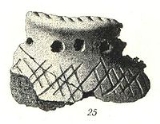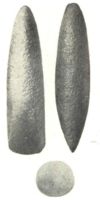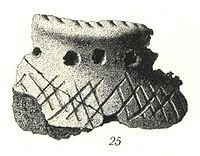
Pitted Ware culture
Encyclopedia

Hunter-gatherer
A hunter-gatherer or forage society is one in which most or all food is obtained from wild plants and animals, in contrast to agricultural societies which rely mainly on domesticated species. Hunting and gathering was the ancestral subsistence mode of Homo, and all modern humans were...
culture
Archaeological culture
An archaeological culture is a recurring assemblage of artifacts from a specific time and place, which are thought to constitute the material culture remains of a particular past human society. The connection between the artifacts is based on archaeologists' understanding and interpretation and...
in southern Scandinavia
Scandinavia
Scandinavia is a cultural, historical and ethno-linguistic region in northern Europe that includes the three kingdoms of Denmark, Norway and Sweden, characterized by their common ethno-cultural heritage and language. Modern Norway and Sweden proper are situated on the Scandinavian Peninsula,...
, mainly along the coasts of Svealand
Svealand
Svealand , Swealand or Sweden proper is the historical core region of Sweden. It is located in south central Sweden and is one of three lands of Sweden, bounded to the north by Norrland and to the south by Götaland. Deep forests, Tiveden, Tylöskog, Kolmården, separated Svealand from Götaland...
, Götaland
Götaland
Götaland , Gothia, Gothland, Gothenland, Gautland or Geatland is one of three lands of Sweden and comprises provinces...
, Åland, north-eastern Denmark
Denmark
Denmark is a Scandinavian country in Northern Europe. The countries of Denmark and Greenland, as well as the Faroe Islands, constitute the Kingdom of Denmark . It is the southernmost of the Nordic countries, southwest of Sweden and south of Norway, and bordered to the south by Germany. Denmark...
and southern Norway
Norway
Norway , officially the Kingdom of Norway, is a Nordic unitary constitutional monarchy whose territory comprises the western portion of the Scandinavian Peninsula, Jan Mayen, and the Arctic archipelago of Svalbard and Bouvet Island. Norway has a total area of and a population of about 4.9 million...
. Despite its Mesolithic
Mesolithic
The Mesolithic is an archaeological concept used to refer to certain groups of archaeological cultures defined as falling between the Paleolithic and the Neolithic....
economy, it is by convention classed as Neolithic
Neolithic
The Neolithic Age, Era, or Period, or New Stone Age, was a period in the development of human technology, beginning about 9500 BC in some parts of the Middle East, and later in other parts of the world. It is traditionally considered as the last part of the Stone Age...
, since it falls within the period in which farming reached Scandinavia. It was first contemporary and overlapping with the agricultural Funnelbeaker culture
Funnelbeaker culture
The Funnelbeaker culture, short TRB from Trichterbecherkultur is the principal north central European megalithic culture of late Neolithic Europe.- Predecessor and successor cultures :...
, and later with the agricultural Corded Ware culture
Corded Ware culture
The Corded Ware culture , alternatively characterized as the Battle Axe culture or Single Grave culture, is an enormous European archaeological horizon that begins in the late Neolithic , flourishes through the Copper Age and culminates in the early Bronze Age.Corded Ware culture is associated with...
.
Economy
The economy was based on fishing, hunting and gathering of plants. Pitted Ware sites contain bones from elk, deer, beaver, seal, porpoise, and pig. Pig bones found in large quantities on some Pitted Ware sites emanate from wild boar rather than domestic pigs.Seasonal migration was a feature of life, as with many other hunter-gatherer communities. Pitted Ware communities in Eastern Sweden probably spent most of the year at their main village on the coast, making seasonal forays inland to hunt for pigs and fur-bearing animals and to engage in exchange with farming communities in the interior.
This type of seasonal interaction may explain the unique Alvastra Pile Dwelling in south-western Östergötland
Östergötland
Östergötland, English exonym: East Gothland, is one of the traditional provinces of Sweden in the south of Sweden. It borders Småland, Västergötland, Närke, Södermanland, and the Baltic Sea. In older English literature, one might also encounter the Latinized version, Ostrogothia...
, which belongs to the Pitted Ware culture as far as the pottery is concerned, but to the Funnelbeaker culture in tools and weapons.
Tools
The repertoire of Pitted Ware tools varied from region to region. In part this variety reflected regional sources of raw materials. However the use of fish-hooks, harpoons, and nets and sinkers was fairly widespread. Tanged arrow heads made from blades of flintstone are abundant on Scandinavia's west coast, and were probably used in the hunting of marine mammals.Ceramics

Pottery
Pottery is the material from which the potteryware is made, of which major types include earthenware, stoneware and porcelain. The place where such wares are made is also called a pottery . Pottery also refers to the art or craft of the potter or the manufacture of pottery...
on its sites. The culture has been named after the typical ornamentation of its pottery: horizontal rows of pits pressed into the body of the pot before firing.
Though some vessels are flat-bottomed, others are round-based or pointed-based, which would facilitate stable positioning in the soil or on the hearth. In shape and decoration, this ceramic reflects influences from the Comb Ceramic culture (also known as Pit-Comb Ware) of Finland and other parts of north-eastern Europe, established in the sixth and fifth millennia BC.
Small animal figurines were modelled out of clay, as well as bone. These are also similar to the art of the Comb Ware culture. A large number of clay figurines have been found at Jettböle on the island of Åland, including some which combine seal and human features.
Graves
Its grave customs are not well known, but Västerbjers on the island of GotlandGotland
Gotland is a county, province, municipality and diocese of Sweden; it is Sweden's largest island and the largest island in the Baltic Sea. At 3,140 square kilometers in area, the region makes up less than one percent of Sweden's total land area...
has produced a large number of grave fields, where the limestone
Limestone
Limestone is a sedimentary rock composed largely of the minerals calcite and aragonite, which are different crystal forms of calcium carbonate . Many limestones are composed from skeletal fragments of marine organisms such as coral or foraminifera....
has preserved the graves well. In these graves, archaeologists found skeletons laid on their backs with well-preserved tools in bone and horn. Numerous imported objects testify to good connections with the Scandinavian mainland, Denmark and Germany.
Genetics
A theory among archaeologists was that the Pitted Ware culture evolved from the Funnelbeaker culture by a process of abandonment of farming for hunting and fishing. However the two populations are genetically distinct. Samples of skeletal remains from Pitted Ware and Funnelbeaker sites in Sweden yielded mitochondrial DNAMitochondrial DNA
Mitochondrial DNA is the DNA located in organelles called mitochondria, structures within eukaryotic cells that convert the chemical energy from food into a form that cells can use, adenosine triphosphate...
(mtDNA). The nineteen Pitted Ware samples from Gotland
Gotland
Gotland is a county, province, municipality and diocese of Sweden; it is Sweden's largest island and the largest island in the Baltic Sea. At 3,140 square kilometers in area, the region makes up less than one percent of Sweden's total land area...
were dominated by mtDNA haplogroups U4, U5 and U5a, though it should be noted that, because of the low resolution of the tests performed, some haplotypes reported as U4 may actually belong to haplogroup H. By contrast the three Funnelbeaker samples from Gökhem contained no haplogroup U. This is consistent with findings elsewhere in northern Europe of a distinct difference in mtDNA between hunter-gatherers and farmers.
A very low level (5%) of an allele (-13910*T) strongly associated with the ability to consume unprocessed milk at adulthood was found among Pitted Ware Culture individuals in Gotland, Sweden. This frequency is dramatically different from the extant Swedish population (74%).
Language
As the language left no records, its linguistic affiliations are uncertain. It has been suggested that its people spoke a language related to the Uralic languagesUralic languages
The Uralic languages constitute a language family of some three dozen languages spoken by approximately 25 million people. The healthiest Uralic languages in terms of the number of native speakers are Hungarian, Finnish, Estonian, Mari and Udmurt...
and provided the unique linguistic features discussed in the Germanic substrate hypothesis
Germanic substrate hypothesis
The Germanic substrate hypothesis is an attempt to explain the distinctive nature of the Germanic languages within the context of the Indo-European language family...
.

